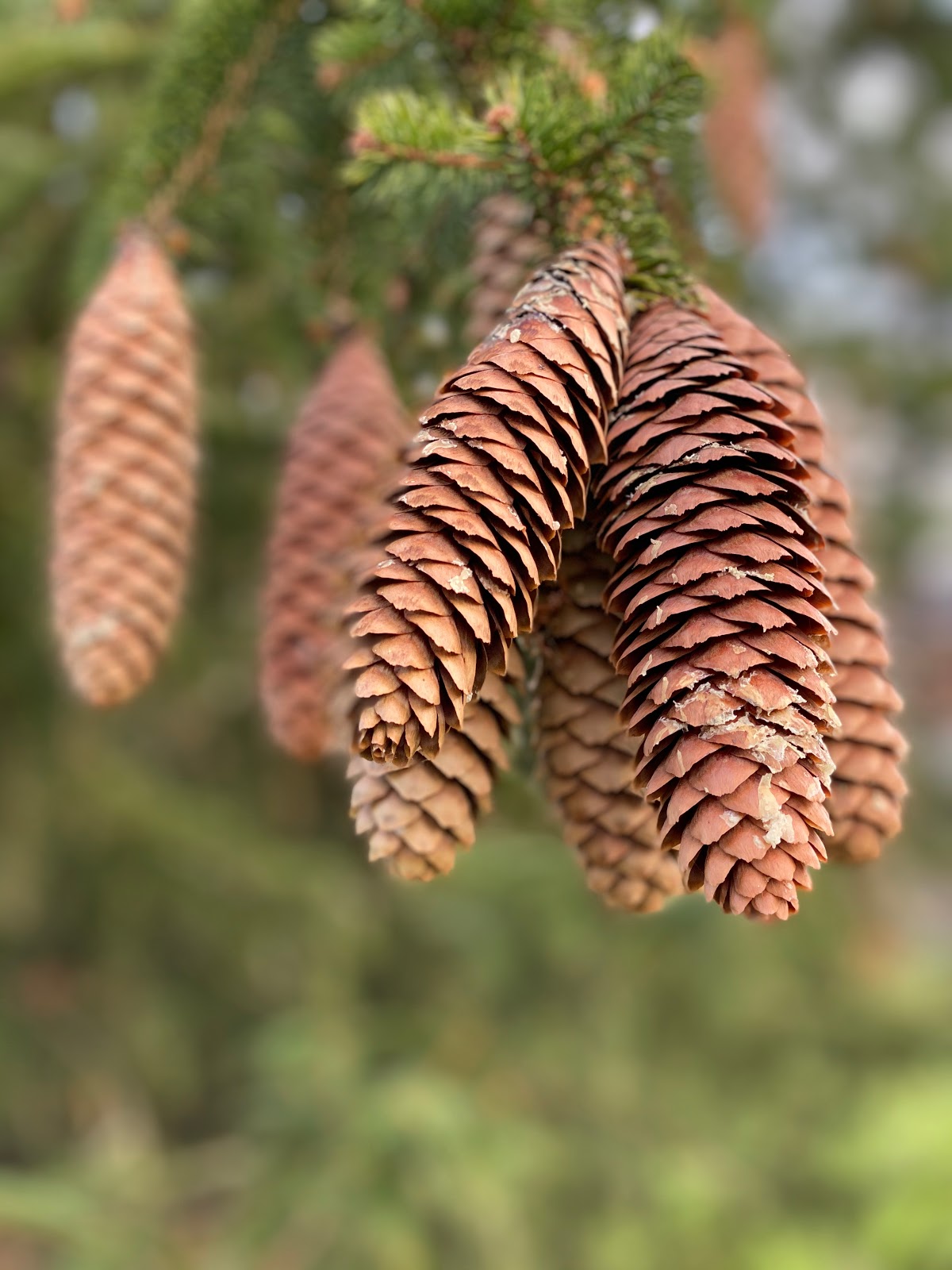
They are declaring 2019 is a mast year for trees.
A mast year is when all kinds of trees collectively produce more than their normal amount of seed.
Really, look it up. Just do an online search for “mast year 2019” and behold all the articles and posts about this phenomenon.
You can also read that scientists and others don’t really understand how it is that all the trees seem to coordinate their efforts, so to speak, to abundantly flower and produce massive amounts of seed in the same year.
I’ve noticed the phenomenon of the mast year on my spruce trees this summer. I have two spruce trees. In the back, I have a large Norway spruce, Picea abies (which the computer wants to auto-correct to “babies” which might be the case with all the cones it has produced).
In the front I have another spruce, Picea orientalis ‘Green Knight’, which has an equally impressive number of cones on it, though they are much smaller and much higher up.
The cones I pictured here from my Norway spruce are low enough to smack me on the top of my head when I mow in that area. And then later I forget I got smacked on my head by those cones and wonder how I got sticky sap in my hair. So now I wear a hat, as one should out in the sun, and get the sticky stuff on my hat.
When you read about mast years, it is mostly oaks that people refer to because all those acorns eventually fall to the ground and are quite noticeable.
If you are lucky, a hoard of ravenous squirrels will scoop up all those acorns and bury them a long way from your garden. If they bury the acorns in your garden, let’s just hope they remember where they are and dig them up to eat before the acorns have a chance to germinate and you have thousands of oak seedlings all over.
The good news is squirrels are supposed to have incredible memories, so if you have squirrels and lots of acorns, I wouldn’t get too concerned about waking up this spring and finding your garden overcome by oak tree seedlings. The squirrels will find their buried food in due time, or most of it.
The bad news about the squirrels’ allegedly incredible memories is they might be memorizing stuff about you. When I am planting crocuses in the lawn in the fall, which I did last week, squirrels might have been hiding in my big spruce and spying on me, memorizing where I planted each corm. I console myself that they can’t possibly remember 500 places. But if they work together—divide and conquer—each taking a section of the yard to memorize, my crocus lawn is doomed.
My sister sent me a picture of the acorns on the ground under her 60-year-old scarlet oak, Quercus coccinea. She wanted to know if it meant the tree was dying or if it is a sign we are going to have a hard winter. It is neither. Mast years are a mystery to scientists. They don’t know why or how or what meaning to derive from them. But I’m sure they’ll use this year as an opportunity to study the phenomenon a little more closely and try to figure it out.
Personally, I don’t want to know why there are mast years. I’m just happy the squirrels presumably have something better to eat than my crocus corms. I hope they realize that and hoard acorns accordingly!


Interestingly, we’ve had exactly the opposite on oaks and walnuts this year here in Asheville North Carolina. Some years the walnuts are so heavy on the trail it’s difficult to walk safely where is this year they were virtually none. Likewise several oaks in our neighborhood that often totally cover the sidewalk with acorns have dropped almost no acorns this year.
Funny that you should write about this. I was just thinking the other day that our weeping spruce had more cones on it than I have ever seen. I attributed it to its age. Hmmmmm Now I know it is Mast Year.
That is so very interesting!! Thanks for the information!
I believe I've read it is because the massive number of cones/nuts is too many for the nearby harvesters (squirrels, deer, etc.) to get them all, and so there are extra to germinate and reproduce. If the trees produced the same number each year, the feeders would become just the right number to eat them all, and then none left to germinate.
I suspect it is weather related. A goodly amount of rain at exactly the right time, for example.
Our transovite Ginko tree which started out as a male tree, turned into a female a few years ago and started to grow berry's. If you know Ginko they have seed fruit that has a very pungent smell (actually they stink). Well this year the fruit has been over produced. To say the least it put out many, many berry's. (peeyou). If you don't know, Ginko trees are a very, very old tree that was around when the great Dino's roamed the earth. I think the smell kept the critters from eating the fruit and that's how they have survived for so long. Cleaning up the leaves and berry's is a very smelly job. Scrubbed my shoes with bleach and they still stink. They may have started the mast year.